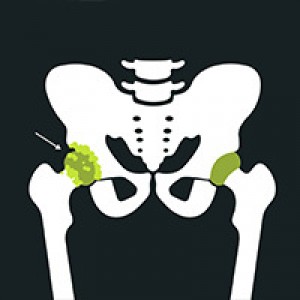HIP PAIN
Do you have pain in your hip? Here, you can learn what causes hip pain and what you can do about it.
Hip pain is one of the most common types of pain. Interestingly, people affected by it often can’t say exactly where the pain in their hip/pelvis is. That’s because your hip, groin, buttocks and lower back are connected to each other via fascial structures. If the natural muscular and fascial tensions in the hip become imbalanced, this causes hip pain.
WHAT IS HIP PAIN?
More and more young people are getting acute or chronic pain in their hips – pain that comes on suddenly or lasts for longer than three months. The pain can come on after physical exertion, but can also happen when resting. In medical terms, hip pain is known as “coxalgia”. Many people affected by it confuse hip pain with osteoarthritis of the hip. But osteoarthritis is only one possible cause of the pain, which means a hip replacement isn’t necessarily on the horizon. More often, a combination of tightening, shortening, and sticking of muscles and fascia leads to misalignment. Pain is a sign that your body is no longer able to functionally compensate for these misalignments.
WHAT ARE THE SYMPTOMS OF HIP PAIN?
The symptoms associated with hip pain depend on what is causing it. Often, people will experience pain in the hip when standing up, pain in the hip when walking, pain in the hip when lying on their side, or pain in the hip after running, and pain in the following areas:
- Inside of hip
- Outside of hip
- Thigh
- Groin area
- Buttocks
HIP PAIN: WHEN SHOULD YOU SEE A DOCTOR, AND WHICH SPECIALIST DO YOU NEED?
If your pain severely limits your everyday life, go see a doctor. They will be able to check whether you have any structural changes like osteoarthritis of the hip, an inflamed tendon, fractured or broken bones, or bursitis (inflammation of the bursa).
The type of pain you have will determine whether you need to see a doctor. You are the best judge of whether you need it investigated further. If in doubt, it’s better to be safe than sorry. The first thing to do is pay your family doctor a visit. If needed, they can then refer you to the right specialist – an orthopedist, internist, rheumatologist or surgeon.
Do you have acute pain? Maybe after an accident or fall? Then it’s crucial that you see a doctor.
But don’t forget: chronic pain in the hip area is often caused by tightness in your myofascial system. You can soothe this tightness using manual therapy techniques.
HOW DOES HIP PAIN START?
Shortened muscles or fascial adhesions are often the cause of the problem. If we want to understand how hip pain starts, we first need to take a look at how the hip joint is structured.
Your hip joint connects your pelvis to your thigh. The hip joint is a ball-and-socket joint. After the knee, the hip joint is the second largest joint in the human body, and carries around 60% of your body weight. The inside and outside of the joint capsule have ligaments that help add stability. The joint capsule sits within two layers of muscles, which include up to 26 individual muscles. As you can see, the hip joint has a complex structure. That’s why the causes of hip pain can vary considerably, and it’s essential to get the right diagnosis for treating it.
HIP PAIN CAN BE CATEGORIZED INTO THREE MAIN GROUPS ACCORDING TO ITS CAUSE:
1. Hip pain affecting the joint (articular pain)
This includes osteoarthritis, inflammation (arthritis), osteonecrosis of the femoral head (when thigh bone tissue dies off) and hip impingement.
2. Hip pain around a joint (periarticular pain)
Pain more often comes from the structures surrounding the hip (muscles, tendons, ligaments, bursae). You will often notice this on the outer side of the hip.
3. Hip pain radiating from other body parts
The pain could originate in the lumbar spine, knee, or sacroiliac joint and radiate out to the hip.
Of course, in practice, it’s not always possible to link pain to one of these specific areas. It’s not uncommon to find a combination these three areas leading to hip pain. Still, it can help to be aware of these three areas. This is the only way you can judge where the pain might be coming from.
DR. TORSTEN PFITZER, HOLISTIC PAIN THERAPIST AND HEALTH COACH:
“In the vast majority of cases, hip pain is due to too much tension and shortening in the muscles and fascia, caused by uneven loads during sport or everyday working
life. If these imbalances aren’t addressed using myofascial exercises, the increased pressure will cause the joint cartilage to wear away faster. This results in extensive
osteoarthritis. If you want to self-treat the pain in your hip in good time, the BLACKROLL® exercises are an incredibly effective tool.”
TREATING HIP PAIN
Sadly, there’s no magic cure for hip pain. As is so often the case, you need to tackle the causes to resolve the problem in the long term. BLACKROLL® products are especially useful for helping you relieve periarticular pain in the hip, and hip pain that radiates from other parts of the body. Of course, manual therapy from a physiotherapist combined with physical techniques (electrotherapy, cold/heat therapy, etc.) can certainly help reduce pain. The important thing is that you combine these passive techniques with active ones.
What does that involve? A change in lifestyle and a lot of patience. But don’t worry: with the right techniques, you’ll be able to free yourself from hip pain.
1.) Mobilizing and loosening muscles around the hip
Using conventional fascia training with BLACKROLL® products will help you loosen up the structures around your hip. This releases tension from your muscles and can alleviate pain. Work on the following areas:
- Hip flexors
- Buttock muscles (glutes)
- Thigh muscles on all sides
- Lower back
2.) Stretching the muscles to restore movement Loosened up your tissue? Great. Now you’ve done that, it’s important to use a range of stretching exercises to regain length in the structures around your hip. The aim is to stop the head of your femur from being pulled as strongly in its socket. This is important for preventing osteoarthritis.
3.) Activating and strengthening the muscles around your hip
A lifestyle spent mostly sitting down and one-sided body movements can cause certain muscle groups to waste away. It means our muscle control is no longer as it should be. This causes forces to act on the joint in an unnatural way. By doing targeted strengthening and stability exercises, you can restore the myofascial balance in your body.
HERE’S HOW YOU CAN PREVENT HIP PAIN
Have you got your pain under control? Then make sure it stays that way and make some lifestyle changes:
- When you’re sitting or standing, try to distribute your weight evenly across the chair legs on both sides or across both your legs.
- If you have to sit a lot for your work, incorporate regular breaks for moving around.
- Make sure you eat a balanced diet and keep an eye on your weight.
- Ease tightness with fascia exercises.
- Do regular, selected exercises to activate muscles and increase your mobility.
- Move often (make sure that your movements don’t cause you pain).
There are no products to list in this category.




